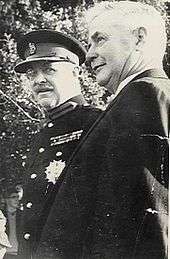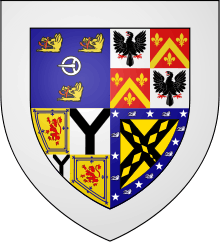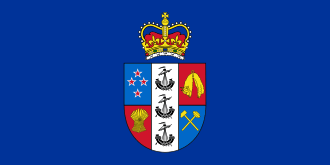Bernard Fergusson, Baron Ballantrae
Brigadier Bernard Edward Fergusson, Baron Ballantrae, KT, GCMG, GCVO, DSO, OBE (6 May 1911 – 28 November 1980)[1] was a British Army officer, a military historian and the last British-born Governor-General of New Zealand.
The Lord Ballantrae KT, GCMG, GCVO, DSO, OBE | |
|---|---|
.jpg) | |
| 10th Governor-General of New Zealand | |
| In office 9 November 1962 – 20 October 1967 | |
| Monarch | Elizabeth II |
| Preceded by | The Viscount Cobham |
| Succeeded by | Sir Arthur Porritt |
| Personal details | |
| Born | 6 May 1911 |
| Died | 28 November 1980 (aged 69) London, England |
| Nationality | British |
| Relations | David Boyle, 7th Earl of Glasgow (grandfather) Sir James Fergusson (grandfather) Sir Charles Fergusson (father) |
| Military service | |
| Allegiance | United Kingdom |
| Branch/service | British Army |
| Years of service | 1931–1958 |
| Rank | Brigadier |
| Unit | Black Watch |
| Commands | 1st Battalion, Black Watch 16th Infantry Brigade |
| Battles/wars | Arab revolt in Palestine Second World War Palestine Emergency |
| Awards | Distinguished Service Order Officer of the Order of the British Empire Mentioned in Despatches |
Early life and family
Fergusson was born on 6 May 1911, the third son and fourth child of Sir Charles Fergusson, 7th Baronet and his wife Lady Alice Mary Boyle, a daughter of David Boyle, 7th Earl of Glasgow. His older brother was Sir James Fergusson, 8th Baronet of Kilkerran. Both his grandfathers had previously served as Governors of New Zealand and his father had served as Governor-General.
Fergusson married Laura Margaret Grenfell (born 14 April 1920, died 1979) on 22 November 1950 and they had one child, Hon George Duncan Raukawa Fergusson (born 30 September 1955)[2] who served as British High Commissioner to New Zealand from 2006 to 2010 and Governor of Bermuda from 2012.
Laura, Lady Ferguson was accidentally killed in 1979 when gales blew a tree onto the car in which she was travelling.[3]
Military career, 1931–1946
Fergusson was educated at Eton College and the Royal Military College, Sandhurst. From the latter, he was commissioned as a second lieutenant into the Black Watch on 27 August 1931.[4] He was promoted to lieutenant on 27 August 1934.[5] He served with the 2nd Battalion of his regiment in the British Mandate of Palestine during the Arab revolt and later became aide-de-camp (ADC) to Major General Archibald Wavell, then General Officer Commanding of the 2nd Infantry Division in England, on 11 March 1937.[6] In October 1937, he was on secondment to the Green Howards.[7] Fergusson was promoted to captain on 27 August 1939, only a few days before the outbreak of the Second World War.[8]
In 1940, Fergusson was serving as a brigade major for the 46th Infantry Brigade before becoming a general staff officer in the Middle East. In October 1943 he was promoted to acting brigadier and given command of the 16th Infantry Brigade, which was converted into a Chindit formation for operations in the deep jungles of Burma miles behind Japanese lines. He commanded this brigade throughout the Chindit operations of 1944 before becoming Director of Combined Operations from 1945 to 1946. He ended the war as a major (war-substantive lieutenant-colonel).
After the war, Fergusson held various positions, including command of the 1st Battalion, Black Watch.
Service in the British Mandate of Palestine, 1946–1947
In 1946, having failed his attempt to be elected to parliament, Fergusson returned to Palestine during the Palestine Emergency in the rank of a brigadier, and was appointed to several positions in British Mandate of Palestine police and para-military forces. At first he served as the commander of the "Police Mobile Force", a police unit of 2,000 British soldiers, that was used as a strike force against the Jewish insurrection. By the end of 1946 the unit was disbanded, by the order of the Palestine Police commandant, Col. William Nicol Gray. Fergusson was appointed as the commander of a police school that was supposed to be created in Jenin, but soon he was appointed by Gray to be "Special assistant to the commandant of police".
Fergusson suggested to Gray, who was himself a former Royal Marine, that a special unit to fight Jewish insurrectionists be formed. This unit would include former soldiers who had served in the British special forces during the war. Gray accepted the idea and ordered the creation of two teams, whose members were chosen from Palestine policemen and ex-SAS soldiers. One team would operate in Haifa and the north, while the second team would operate in the Jerusalem area. War hero Roy Farran was appointed as the commander of the second team.
On 6 May 1947, Farran's unit arrested 16-year-old Alexander Rubowitz, who was putting up posters in Jerusalem for the Jewish underground organisation the Lehi. Rubowitz was taken by Farran's team, and tortured to force him to surrender his friend's names. The boy did not survive the torture. His body was dumped and never found. Suspicions of Farran's involvement were first raised after a grey trilby hat, bearing an indistinct name compatible with his, was found near the street corner where Rubowitz was seen being pushed into a car. In 2004 British secret documents were revealed that included a statement by Fergusson, written at the time of the event, to the effect that Farran confessed to Fergusson of the murder. Fergusson then reported the incident to Gray.[9]
Gray was reluctant to take action against Farran, believing he could use some information produced from Rubowitz by Farran to crack the Lehi in Jerusalem. Gray believed that arresting Farran would ruin these efforts. While Gray was on leave in England, the acting CID commandant, Arthur Giles, ordered an investigation into Farran's actions. Farran escaped to Syria to avoid arrest, but was convinced by Fergusson to return voluntarily. He then escaped from custody and went to Jordan before again returning of his own accord. He was brought to trial in a British military court in Jerusalem.
At Farran's trial, Fergusson refused to testify on the grounds that he might incriminate himself. The Palestine government announced that no action would be taken against Fergusson. After the trial, which ended with Farran's acquittal, Fergusson was relieved of his duties in Palestine and returned to Britain.[10][11]
Military career, 1951–1958
Fergusson was brevetted to lieutenant colonel on 1 July 1951,[12] promoted to lieutenant colonel on 5 March 1952,[13] and promoted to colonel on 6 May 1952.[14] He retired on 13 December 1958 with the honorary rank of brigadier.[15]
Suez
Gerald Templer was impressed by Fergusson's performance in the Malayan Emergency and during the Suez crisis he was put in charge of the psychological warfare component of Britain's plan to retake the Suez canal and overthrow Nasser. Fergusson made plans for an extensive campaign of propaganda to accompany a ruthless use of air power against Alexandria. The plan eventually employed was very different and consequently psychological warfare had little impact on Egyptian public opinion or morale. British propaganda radio station assertions that Nasser was a tool of Zionism and that Egypt should attack Israel brought strong protests from Golda Meir.[16]
Governor-General of New Zealand

In 1962, Fergusson was appointed Governor-General of New Zealand, serving until 1967. His father Sir Charles Fergusson had also been governor-general, and both of his grandfathers, Sir James Fergusson, 6th Baronet and David Boyle, 7th Earl of Glasgow, had been Governors of New Zealand.
Fergusson was created a life peer on 10 July 1972 as Baron Ballantrae, of Auchairne in the County of Ayrshire and The Bay of Islands in New Zealand.[17]
Lord Ballantrae served as Chancellor of the University of St Andrews from 1973 until his death in 1980.
Memorial scholarship
The Bernard Fergusson Memorial Scholarship was established in 1982 by the late Maori Queen, Dame Te Atairangikaahu, from a fund raised on her behalf in memory of Fergusson, as he was a particular friend of the Tainui people.
The purpose of the award is to assist a member of the Tainui Tribal Confederation resident in the Tainui Maori Trust Board area to enrol as an undergraduate student in the University of Waikato, who but for the award, might otherwise not be able to attend the University.[18]
Due to his relationship with Tainui, a Ngāruawāhia Primary School was named after him in 1966.[19] Over the years, many students from the school would go on to receive the memorial scholarship.
Styles
- 6 May 1911 – 5 August 1943: Bernard Edward Fergusson, Esq.
- 5 August 1943 – 8 June 1950: Bernard Edward Fergusson DSO
- 8 June 1950 – 3 September 1962: Bernard Edward Fergusson DSO, OBE
- 3 September – 9 November 1962: Sir Bernard Edward Fergusson GCMG, DSO, OBE
- 9 November 1962 – 11 February 1963: His Excellency Sir Bernard Edward Fergusson GCMG, DSO, OBE, Governor-General and Commander-in-Chief of New Zealand
- 11 February 1963 – 20 October 1967: His Excellency Sir Bernard Edward Fergusson GCMG, GCVO, DSO, OBE, Governor-General and Commander-in-Chief of New Zealand
- 20 October 1967 – 10 July 1972: Sir Bernard Edward Fergusson GCMG, GCVO, DSO, OBE
- 10 July 1972 – 30 November 1974: The Rt. Hon. the Lord Ballantrae GCMG, GCVO, DSO, OBE
- 30 November 1974 – 28 November 1980: The Rt. Hon. the Lord Ballantrae KT, GCMG, GCVO, DSO, OBE
Honours and awards
| Knight of the Order of the Thistle (KT) | 30 November 1974[20] | |
| Knight Grand Cross of the Order of St Michael and St George (GCMG) | 3 September 1962[21] | |
| Knight Grand Cross of the Royal Victorian Order (GCVO) | 11 February 1963[22] | |
| Companion of the Distinguished Service Order (DSO) | 5 August 1943 (Burma)[23] | |
| Officer of the Order of the British Empire (OBE) | King's Birthday Honours, 8 June 1950[24] | |
| Knight of the Order of St John (KStJ) | 1961[25] | |
| General Service Medal | with 3 clasps | |
| 1939-1945 Star | ||
| Africa Star | ||
| Burma Star | ||
| Defence Medal | ||
| War Medal 1939–1945 | with MiD | |
| Queen Elizabeth II Coronation Medal | 1953 |
Arms
 |
|
Bibliography
- Eton Portrait (1937) London: John Miles Ltd.
- Beyond the Chindwin (1945) London: Collins ISBN 0-00-613870-5 also Barnsley: Pen & Sword Military (2009) ISBN 1-84884-037-3
- Lowland Soldier (1945) London: Collins (verse)
- The Wild Green Earth (1946) London: Collins
- The Black Watch and the King's Enemies (1950) London: Collins also Derby: Pilgrim Press (1974) ISBN 0-900594-27-6
- Rupert of the Rhine (1952) London: Collins
- The Rare Adventure (1954) London: Collins
- The Business of War: The War Narrative of Major-General Sir John Kennedy (1957) (editor) London: Hutchinson
- The Watery Maze: The Story of Combined Operations (1961) London: Collins
- Wavell: Portrait of a Soldier (1961) London: Collins
- Return to Burma (1962) London: Collins
- The Trumpet in the Hall 1930–1958 (1970) London: Collins ISBN 978-0-00-211825-5
- Captain John Niven (1972) London: Collins ISBN 0-00-192148-7
- Hubble-Bubble (1978) London: Collins ISBN 0-00-211378-3 (light verse)
- Travel Warrant (1979) London: Collins ISBN 0-00-216792-1
References
- Ronald Lewin, ‘Fergusson, Bernard Edward, Baron Ballantrae (1911–1980)’, rev., Oxford Dictionary of National Biography, Oxford University Press, 2004 accessed 3 April 2009
- The Peerage, entry for Laura Grenfell
- The Daily Mail, published 22 April 2012
- "No. 33748". The London Gazette. 28 August 1931. p. 5624.
- "No. 34082". The London Gazette. 28 August 1934. p. 5461.
- "No. 34379". The London Gazette. 12 March 1937. p. 1642.
- "No. 34459". The London Gazette. 30 November 1937. p. 7517.
- "No. 34660". The London Gazette. 29 August 1939. p. 5918.
- Nick Kardahji (2007). "A Measure of Restraint: The Palestine Police and the End of the British Mandate" (PDF). MPhil Thesis, Modern Middle East Studies. Retrieved 5 June 2010.
- Farran, Fergusson may be in UK, Palestine Post, 1947/10/08
- No action against Col. Fergusson, Palestine Post, 1947/10/16
- "No. 39397". The London Gazette (Supplement). 27 November 1951. p. 6239.
- "No. 39543". The London Gazette (Supplement). 16 May 1952. p. 2708.
- "No. 39764". The London Gazette (Supplement). 27 January 1953. p. 617.
- The London Gazette, 16 December 1958
- Kyle, K. (2003). Suez: Britain's end of empire in the Middle East. London: Tauris. pp. 235–239. ISBN 1-86064-811-8.
- "No. 45725". The London Gazette. 13 July 1972. p. 8375.
- "Archived copy". Archived from the original on 24 July 2011. Retrieved 2010-03-30.CS1 maint: archived copy as title (link)
- "A Brief History". Te Kura Kaupapa Māori o Bernard Fergusson. Retrieved 22 November 2019.
- "No. 46421". The London Gazette. 3 December 1074. p. 12169.
- "No. 42776". The London Gazette. 7 September 1962. p. 7041.
- "No. 42969". The London Gazette (Supplement). 16 April 1963. p. 3327.
- "No. 36120". The London Gazette (Supplement). 5 August 1943. p. 3522.
- "No. 38929". The London Gazette (Supplement). 8 June 1950. p. 2781.
- "No. 42722". The London Gazette. 3 July 1962. p. 5305.
External links
| Government offices | ||
|---|---|---|
| Preceded by The Viscount Cobham |
Governor-General of New Zealand 1962–1967 |
Succeeded by Sir Arthur Porritt |
| Academic offices | ||
| Preceded by The 14th Duke of Hamilton |
Chancellor of the University of St Andrews 1973–1980 |
Succeeded by Kenneth Dover |
